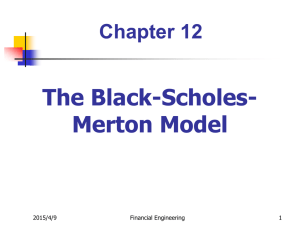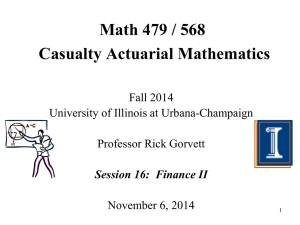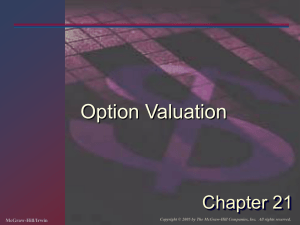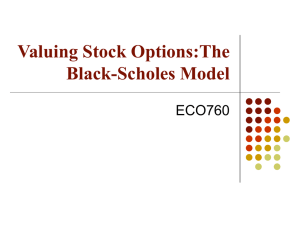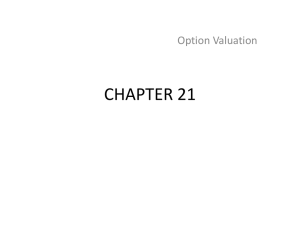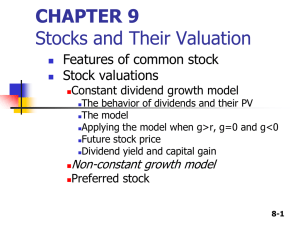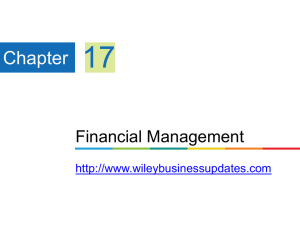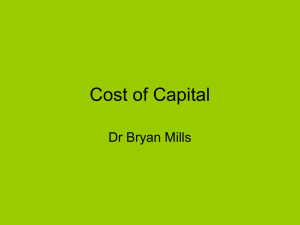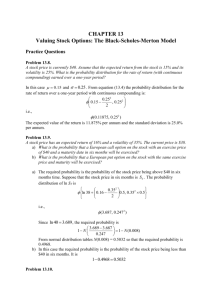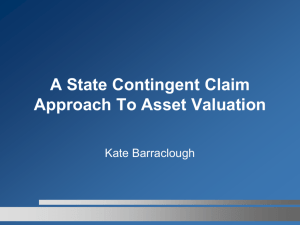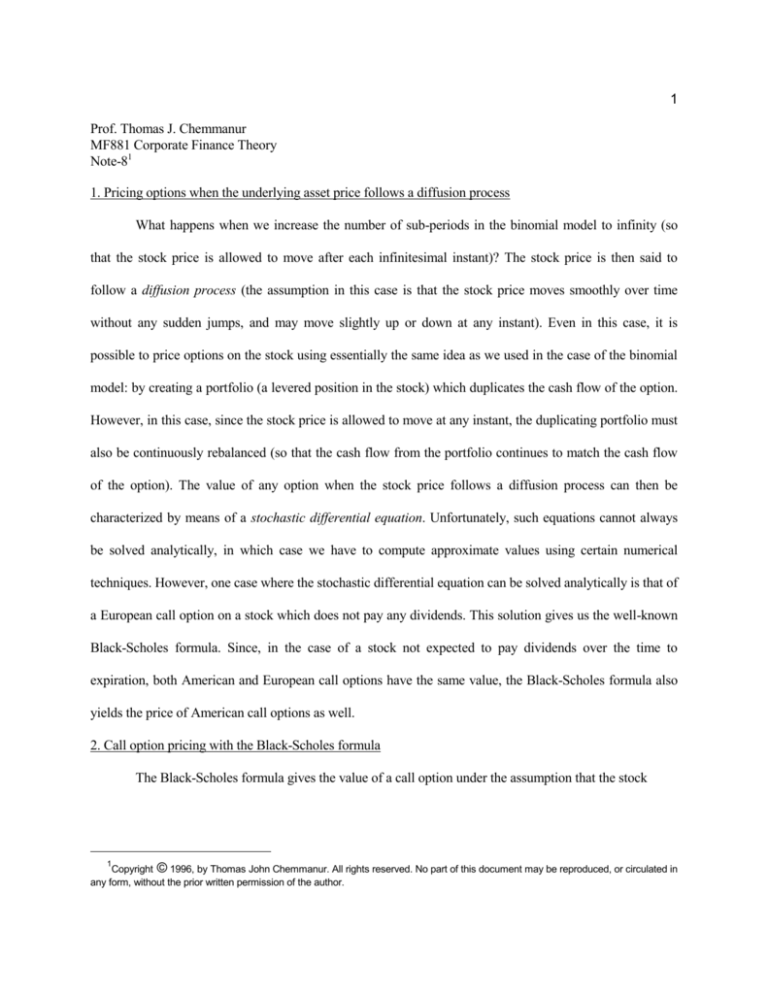
1
Prof. Thomas J. Chemmanur
MF881 Corporate Finance Theory
Note-81
1. Pricing options when the underlying asset price follows a diffusion process
What happens when we increase the number of sub-periods in the binomial model to infinity (so
that the stock price is allowed to move after each infinitesimal instant)? The stock price is then said to
follow a diffusion process (the assumption in this case is that the stock price moves smoothly over time
without any sudden jumps, and may move slightly up or down at any instant). Even in this case, it is
possible to price options on the stock using essentially the same idea as we used in the case of the binomial
model: by creating a portfolio (a levered position in the stock) which duplicates the cash flow of the option.
However, in this case, since the stock price is allowed to move at any instant, the duplicating portfolio must
also be continuously rebalanced (so that the cash flow from the portfolio continues to match the cash flow
of the option). The value of any option when the stock price follows a diffusion process can then be
characterized by means of a stochastic differential equation. Unfortunately, such equations cannot always
be solved analytically, in which case we have to compute approximate values using certain numerical
techniques. However, one case where the stochastic differential equation can be solved analytically is that of
a European call option on a stock which does not pay any dividends. This solution gives us the well-known
Black-Scholes formula. Since, in the case of a stock not expected to pay dividends over the time to
expiration, both American and European call options have the same value, the Black-Scholes formula also
yields the price of American call options as well.
2. Call option pricing with the Black-Scholes formula
The Black-Scholes formula gives the value of a call option under the assumption that the stock
1
Copyright © 1996, by Thomas John Chemmanur. All rights reserved. No part of this document may be reproduced, or circulated in
any form, without the prior written permission of the author.
2
price follows a diffusion process.2 The formula also provides a way to calculate (and update continually) the
hedge-ratio (i.e., the number of shares per option) and the amount of borrowing required to replicate the call
option. The formula gives the price of the call option (C) as a function of five inputs: (1) The current stock
price, S; (2) the option's exercise price, X; (3) the option's time to maturity expressed in years, T; (4) the
continuously compounded risk-free interest rate per year, R; (5) the stock's volatility, as measured by the
standard deviation of the (continuously compounded) annual return on the stock, . It is given by:
C = S N ( d 1 ) - X e- R T N( d 2 ),
[ ln(S/X) + (R + 1 / 2 2) T ]
where d1 =
, d 2 = d1 -
T
T.
(1)
Here N(x) is the probability that a standardized, normally distributed random variable will be less than or
equal to any number x (it is given by the area under the standardized normal distribution curve to the left of
the number x). This value can be obtained from the normal distribution tables (given at the back of this
note).
Problem 1: Compute the price of a call option on the stock of ABC company with an exercise price of $49,
given the following data. Current stock price: $50; The option has 199 days to maturity (today's date:
October 4, 19x0; maturity date: April 21, 19x1). Continuously compounded risk-free rate (R): 7% per year.
The volatility (standard deviation) of ABC stock returns is 30% per year.
In the formula (1), the co-efficient of the stock price S in the first term, N(d1), gives the
instantaneous hedge-ratio; this hedge-ratio changes as the stock price changes (note that d1, and hence N(d1),
depends on S). The second term in the formula gives the amount of borrowing required to replicate the call
option. Thus, the basic intuition behind the Black-Scholes formula is exactly the same as in the Binomial
model; the important difference is that the formula gives much more accurate values for the stock price,
2
The specific assumption is that the stock price follows a "random walk", such that the distribution of
possible stock prices at the end of any finite time interval follows a lognormal distribution (this is consistent
with the assumption that stock returns are normally distributed).
3
since the underlying assumption about the stock price is much more realistic in this case.3
It is important to emphasize what the Black-Scholes formula does not depend upon: it does not
depend upon investors' ability to take risk (risk-aversion), nor does it depend upon the expected return on
the stock. Thus investors with different estimates of the expected return will nevertheless agree on the call's
value. This is because, like the Binomial model, the Black-Scholes formula prices the call option as a
function of the current price of the underlying stock, and these factors already enter into determining the
current stock price, which reflects investors' divergent views. Thus, of the five inputs required, the only
input which cannot be directly observed is the volatility of the underlying stock (which can be estimated
from historical data). Because of the fact that most of these inputs are directly observable, the formula is
much more accurate than almost any other asset valuation model in finance.
3. Adjusting Black-Scholes to value an American call on a stock paying dividends before expiration
An option on a stock that is expected to pay a dividend before the expiration date of the option is
worth less than an option on an identical stock that pays no dividend; the higher the dividend, the less the
option is worth. This is because, when the stock goes ex dividend, the stock price usually falls (roughly by
the extent of the dividend), reducing the likelihood that the stock will be above its exercise price, and hence
the value of the option.4 This means that it may make sense to exercise an American call option on a
dividend paying stock prematurely, just before the ex dividend date (but only then). However, this need not
always be the case: sometimes, even after accounting for the loss in value due to a dividend payment, it may
make still sense for the option holder not to exercise it prematurely.
3
The Black-Scholes formula does assume that various frictions associated with trading securities are
absent: i.e., there are no transactions costs involved in buying and selling stock or options and that there are
no penalties to short-selling stock. They also assume that the short term risk-free interest rate is known and
is constant through time, and that it is possible to borrow money at this interest rate in order to buy and hold
securities. These assumptions are clearly unrealistic to some degree, but they do not seem to generate a
significant amount of error in the option pricing formula (see section 9).
4
The exercise price is not usually adjusted downward to compensate the option holder for the potential
loss in value due to the payment of cash dividends.
4
The above discussion provides a simple way to compute (approximately) the value of an American
option on a dividend paying stock. For shorter-term options, the adjustment can be accomplished as follows.
Assume that the stock is expected to pay a dividend D per share on date t, 0 < t < T. The strategy to price the
call is to compute two different values for the call. The first value assumes that the call is exercised on the
ex dividend date (i.e., at date t). Let us denote this value by C(t), which can be computed from the BlackScholes formula by plugging in the smaller time to exercise t instead of T. The second value is computed
under the assumption that the call is held until the actual maturity date T, so that the stock price will fall by
the amount D before the option is exercised. Therefore, we can compute this second value C(T), by
replacing the current stock price S by an adjusted stock price equal to S - D.e-Rt in the Black-Scholes
formula. The call value will then be equal to the larger of these two values C(t) and C(T).
For longer term options, it is a good approximation simply to reduce the riskless rate by the
dividend yield, where the dividend yield y is given by:
y = Current Dividend per Share/Current Stock Price.
Dividend adjusted risk-free rate = r - y
Since the options involved in warrants and in convertible debt are longer term options (typically three years
and above), this is the approximation we will make when valuing warrants and convertibles.
4. How do Black-Scholes call option values compare with real-world option prices?
The call option values provided by the Black-Scholes pricing formula provide quite accurate values
compared with real-world option prices: indeed, the formula is used extensively by options traders. Often,
the difference between computed and real-world market values are of the order of only a few cents.
Empirical studies have shown that option writers receive prices that are roughly about the level predicted by
the formula, while option buyers pay prices which are somewhat higher than that predicted by the formula,
indicative of the fact that the significant transactions costs in the option market are borne by option buyers.
Empirical studies also indicate that the difference between predicted and market values is greater for options
5
on low-risk stocks than for options on high-risk stocks.
6
Appendix: Estimating stock-return volatility to be used in the Black-Scholes option pricing model from
historical data (You will not be tested on this in the exam)5
It is easy to estimate the volatility of the underlying stock price (which, as you know, is an input
into the Black-Scholes option pricing formula) by observing daily stock prices (usually the closing prices
from the last 90 to 180 days is used). Define:
N: number of daily stock price observations used;
Si: Stock price at the end of the ith day.
: length of a day in years (in the case of daily data, this is 1/250, assuming that time is measured in trading
days, since there are about 250 trading days per year).
ui:6 ln(Si/ Si-1)
In order to find the volatility of the stock return, we first estimate its daily standard deviation s
from the historical (daily) stock return data using the equation:
1 i n
s
u i u
(n 1) i 1
(A1)
2
An equivalent formula for s is,
1 i n 2
1 i n
s
ui
ui
n - 1 i 1
n(n 1) i 1
2
(A2)
The volatility is now given by:
Based on the discussion in John Hull, Options, Futures and Other Derivative Securities, Prentice
5
Hall, New Jersey.
Since returns are continuously compounded, Si= Si-1-eu, so that ui is the return on the stock for
the ith day.
6
7
(A3)
s
Example: based on the data from the table below, compute the continuosly compounded annualized stock
return volatility to be used in the Black-Scholes formula.
Day
Closing Stock price Price relative
Daily return
(dollars)
ln(Si/ Si-1)
Si/ Si-1
0
20
1
20.125
1.00625
0.00623
2
19.875
0.98758
-0.01250
3
20
1.00629
0.00627
4
20.5
1.02500
0.02469
5
20.25
0.9781
-0.01227
6
20.875
1.03086
0.03040
7
20.875
1.00000
0.00000
8
20.875
1.00000
0.00000
9
20.750
1.01205
-0.00601
10
21
1.00595
0.00000
11
21.125
0.98817
0.01198
12
20.875
1.00000
0.00593
13
20.875
0.98817
-0.01190
14
20.875
1.00000
0.00000
ui=
8
15
21.250
1.01796
0.01780
16
21.375
1.00588
0.00587
17
21.375
1.00000
0.00000
18
21.250
0.99415
-0.00587
19
21.750
1.02353
0.02326
20
22
1.01149
0.01143
Solution: using the data from the table,
u
i
0.09531
u
2
i
0.00333,
(A4)
so that, using the formula (A2),
0.00333 0.095312
s
0.0123
19
380
yielding
0.0123
0.194, or19.4%
1/250
(A5)
(A6)

